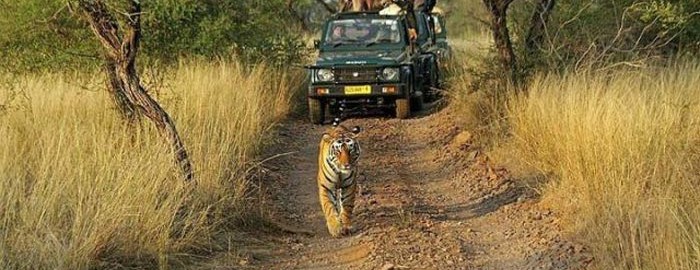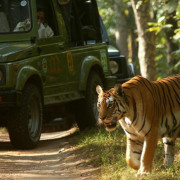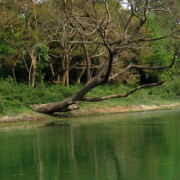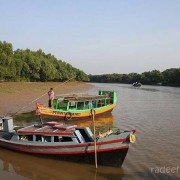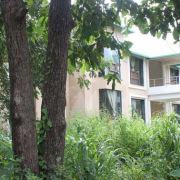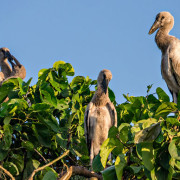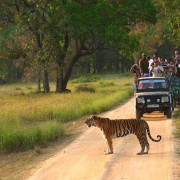Ranthambore National Park, Rajasthan – A paradise for the nature lovers
Ranthambore National Park is the biggest and one of the famous national park in Northern India. The park is located in the Sawai Madhopur district of southeastern Rajasthan, which is about 130 km from Jaipur. It was a popular and former hunting grounds of the Maharajas of Jaipur. Today the Ranthambore National Park terrain is major wildlife tourist attraction spot that has pulled the attention of many wildlife photographers and lovers in this destination.
Stretched over an area of 400 sq. kilometer, the park has two other the Mansingh Sanctuary and the Kaila Devi Sanctuary. It is located in the mid of Aravalli and Vidhya range. The scenery changes dramatically from gentle and steep slopes of the Vindhyas to the sharp and conical hills of the Aravali. Inside the jungle stands the dilapidated old fort of Ranthambore. This tenth century fort also blends accurately with the background. The tigers are the main attraction of the national park thus making it a tiger reserve also.
Places to see at Ranthambore National Park: Ranthambore is counted as the famous heritage site because of the pictorial ruins that dot the wildlife park. Apart from the animals and birds, the natural beauty of the park will cast a magic spell. Certainly, a visit to Ranthambore National Park is a treat for every wildlife and nature lover. The park has some interesting sight seeing locations.
Bakuala
The National Park is covered with thick forest over a large part of its area. One of the thickly forested regions is called the Bakaula region. Bakaula consists of dense forest, with many small pools and water holes in clearings in the vegetation. Because of the excellent forest cover and availability of water, the Bakaula region in National Park Ranthambore has an abundance of wildlife. Tigresses with young cubs are often seen near the water holes in Bakaula, since the dense forest provides cool hides for a tigress and her young. Bakaula is one of the coolest regions of National Park Ranthambore, where many birds can be seen in the trees and small animals like squirrels and monkeys rush through the forest.
Kachida Valley
This valley, consisting of many rocky outcrops and low hills, is located close to the outskirts of the park. A jeep would be the ideal mode of transport when trying to visit this area. This area contains a majority of the Panther population of the park. The panthers avoid venturing into the main jungle to avoid conflicts with tigers, who are known to kill them. This area also has a good population of beers.
Lakarda Anantpura
These areas located in the North-Western and Northern regions of the park are ideal locations to visit if you are looking for Sloth Bears. These areas have a lot of ant hills, which are a favourite of the bears. Although very rarely seen themselves, the pugmarks of the Indian striped Hyenas are often seen here. Their numbers are not very large in the park.
Raj Bagh Ruins
These ruins are located between the Padam Talao (lake) and the Raj Bagh Talao. These ancient stone structures like arches, palace outhouses, domes and steps give the area an aura that is not possible to find anywhere else in the world. Especially if you include the jungle surroundings and are one of the lucky few who come across one of the resident tigers. These ruins are what give the RanthamboreNational Park such a unique mixture of a wildlife reserve and a reminder of the past, which together make it one of the most picturesque parks in the entire world.
Padam Talao
This is the largest of the lakes present in the park. The famous and beautiful Jogi Mahal is located at the very edge of this lake. When in season, the water lilies that give the lake it’s name, can be seen in plenty. In the early hours of the morning and just before sunset, animals can be seen in large numbers on the lake side. It is in the shallow waters of this lake that the famous “lake hunters” of Ranthambore operate, the most legendary of which was the tiger, Genghis. It is also along this lake’s edges that the rare sighting of the chinkara is most probable.
Ranthambore Fort
Standing majestically atop a hill this fort overlooks the entire park. The walk up, one of the only places this mode of transport is possible, is a very refreshing and exciting one as even the big cats have been spotted up there! The view of the surrounding keeps getting better and better as you go up but the view from the fort itself can only be described as breathtaking. It is advisable to take along a good pair of binoculars and if possible a camera with a very powerful lens when visiting the fort.
You can easily catch a glimpse of the soaring Serpent eagles, vultures and other birds. Many animals can also be seen along the edges of all the water bodies, which are all visible from here. The fort itself also offers many interesting architectural and historical sights worth viewing and photographing. A trip to the fort is a must if you are a first time visitor to the park. If you take a guide with a good knowledge of the fort’s history it is really beneficial for you.
Nearby attractions from Ranthambore National Park: There are some renowned destinations across the Ranthambore National Park that can lead you to the most investing exploration.
Agra
Agra has long been renowned as the city of the Taj Mahal. This has often overshadowed the fact that this royal Mughal has, in addition to the legendary Taj, many magnificent monuments that epitomise the high point of the Mughal architectural achievement. Not even Delhi the seat of kings and emperors for over a thousand years, can boast such a heritage of architectural and cultural splendour from the golden age of the Great Mughals.
Bharatpur
The 28.73 sq. km. lake and wetland was artificially created by the Maharaja of Bharatpur in the 19th century. In 1956 as a bird sanctuary, 1981 as a national park. A princely state in the past Bharatpur is also often called the “Eastern Gateway of Rajasthan. Keolodeo Ghana National Park is an important international bio-sphere known for its large and varied avid fauna, both local and migratory. By building small dykes and dams and diverting water from an irrigation canal, he converted this low lying area into a fine wild fowl shooting preserve. In a few years, the new wetland surrounded by marginal forests was able to support thousands of water-birds. Commonly referred to as Bharatpur, the Park is a delight for bird watchers.
Jaipur
Founded by Maharaja Jai Singh II , Jaipur is the capital of Rajasthan. It is a major attraction for the first-time visitor. Jaipur is surrounded on all sides by rugged hills, crowned with forts & enclosed by embattled walls.
The Old City (Known as the Pink City) is a great place to wander around and savour the superb architectural constructions. The whole city was painted in Pink colour by Maharaja Man Singh II when Prince of Wales, later Edward VII, visited Jaipur in 1876 AD. Today, every home within the city is obliged by law to maintain its facade. It is a very well planned city laid out in a grid pattern and was designed by a young Bengali engineer and scholar by the name “Vidyadhar Bhattacharya”.
Things to do at Ranthambore National Park: It is an ideal place of visit for the wild life and nature lovers. Staying amidst the lush green vegetation and catching the glimpse of a number of wild species is in itself a wonderful thing.
Best time to visit Ranthambore National Park: The best time to visit Ranthambore National park is from December and April when the weather is pleasant.
How to go ?
By Air
Jaipur is the nearest airport for RanthamboreNational Park. The Park is located just 180 km away from Jaipur city. One can hire cabs or avail bus services to reach the park.
By Rail
The nearest major railway station is Sawai Madhopur which is well connected to other major cities across India. One can hire a cab or avail the frequent private/public bus services from Sawai Madhopur to reach RanthamboreNational Park.
By Road
Ranthambore National Park is located just 11 km away from Sawai Madhopur and plenty of buses ply between Sawai Madhopur and the park. You can also hire cabs or taxis from Sawai Madhopur to reach your destination.
Where to stay ?
There are adequate lodgings facilities available in Ranthambore. Some options are:
Hotel Vinayak (RTDC): +91-07462- 221333
Hotel Jhumar Bawri: +91-07462-220495
Hotel Ranthambore Bagh: +91-07462-221728 Website: www.ranthambhore.com
Hotel Anurag Resort: +91-07462-220751
Note : Phone numbers given above are according to the information available with us. If you find any contact number/s given above is/are incorrect or not in use, please let us know.
.
.

